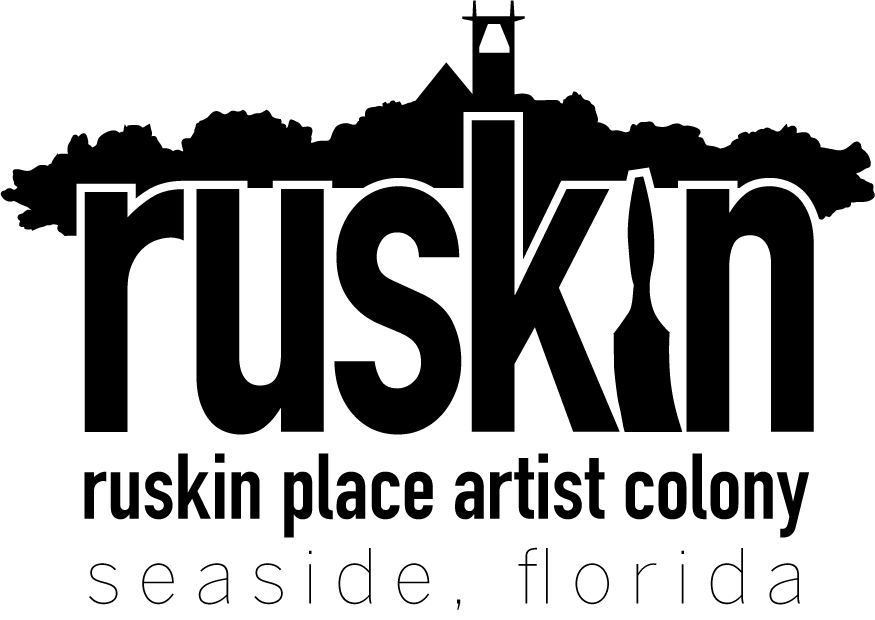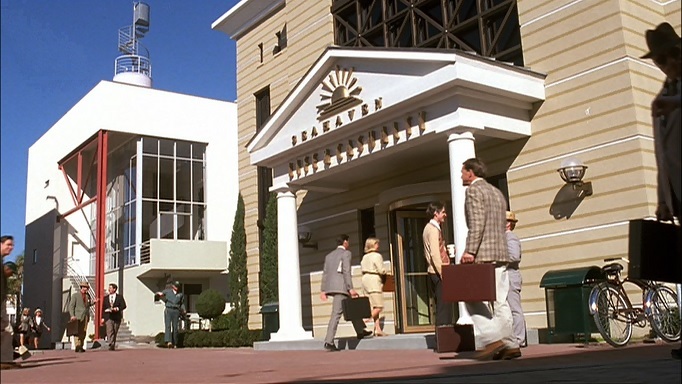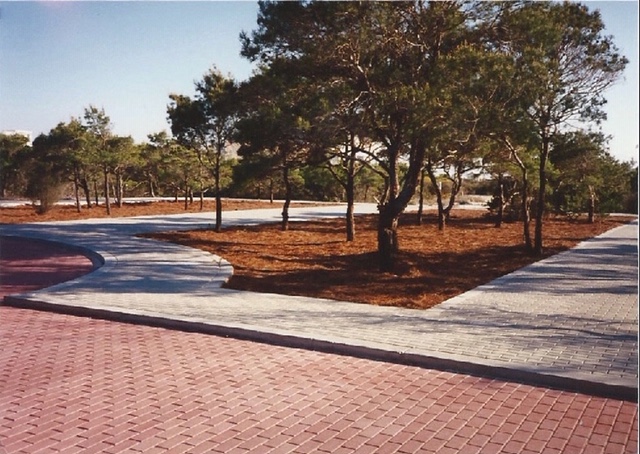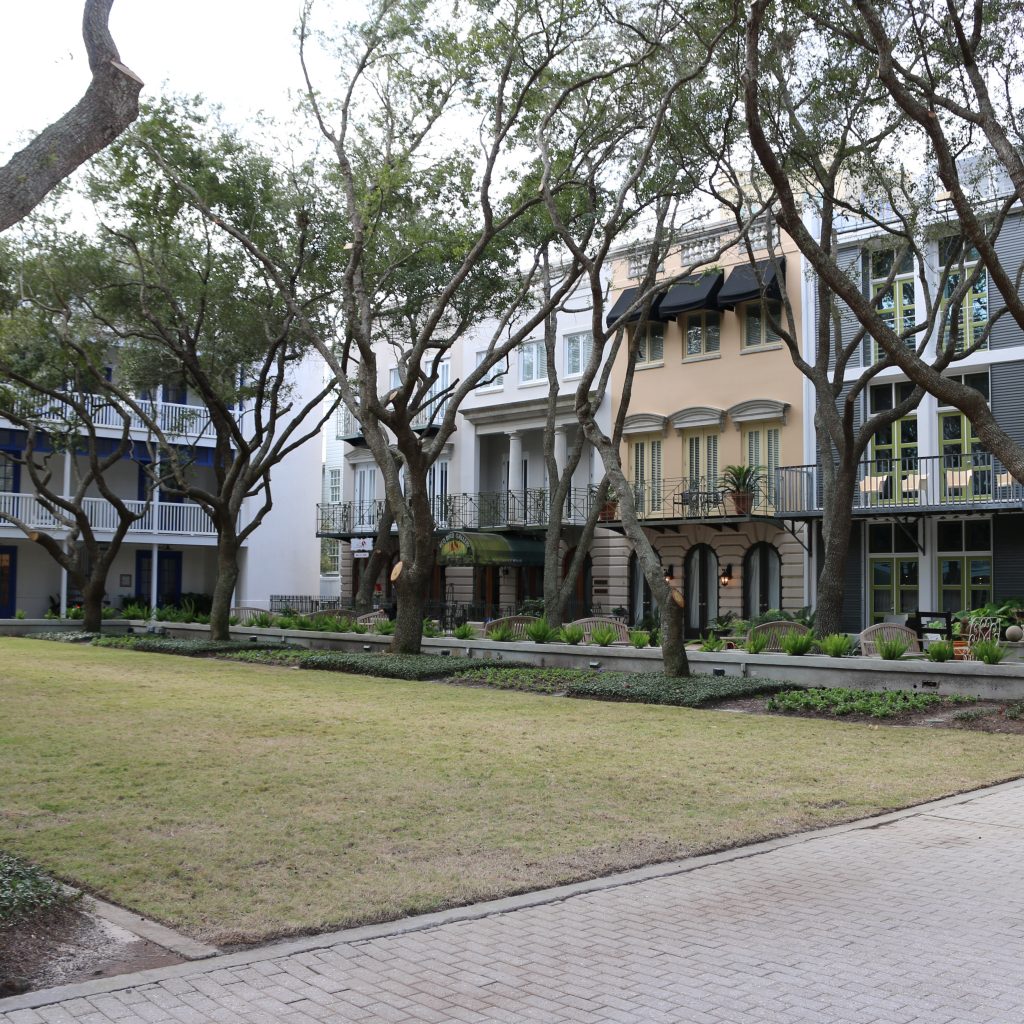History
Courtesy of The Seaside Times – https://seasidefl.com/news
Ruskin Place, Two Decades Later
Idyllic artists colony still makes one linger longer
By Pratt Farmer
Most know that the hit movie, “The Truman Show,” was filmed in Seaside and released in 1998. In fact, the movie producers endowed the Ruskin Place Homeowners Association with $125,000 to renovate their park after production ceased. Many will remember the art deco looking building where Truman went to work every day. That was in Ruskin Place, just north of Central Square, where today you will discover an enclave of townhomes, shops, art studios and people-watchers. Remember in the movie, what Truman says to a fellow co-worker who had stopped to let him enter the revolving doors to the office building? Truman’s response was “I’m not that anxious to get there.” Nothing could be further from the truth today. Everyone is anxious to get to Ruskin Place.
In 1987 Bill and Mary Florence Forsythe read an article in House Beautifulabout a little town in the Florida Panhandle. They were so intrigued by the vision of its founders, Robert and Daryl Davis, they booked a flight from Chicago to Fort Walton Beach that week. Because Mary Florence was a sculptor, the idea of an art colony, within the town of Seaside, where she could sculpt in the ground floor space and they could live above her studio, was intriguing. So much so that they bought a lot before heading back to Chicago. Working with architect Walter Chatham, plans were drawn, revised and finally approved. Their unique home in the quaint village of Ruskin Place was soon to become a reality.
The Forsythes were the first family to begin construction in what is now Ruskin Place Artists Colony, which is comprised of 20 townhomes, all unique. No cookie cutter tract homes allowed. Seaside residents and visitors have discovered the un-matched charm of the townhomes, all facing a park. It’s a European-styled village within a town. Art studios and tiny boutiques offer treasures not found elsewhere. You can chat with homeowners who often sit on their second or third floor balconies to enjoy the park. Listen and you might hear classical music from a home on the eastern side of the park. Say ‘hello” if you think about it! Today the park in Ruskin Place is almost completely covered by a canopy of sand live oaks surrounded by a well laid out pattern of walls, wooden benches and ground cover. The park has evolved, matured and welcomed thousands since it was built.
As mentioned, the park in Ruskin Place wasn’t always like it is today. With the gift from the movie producers, the Forsythes and other homeowners got together to talk about designing and building a new park that would be more of a respite from the hustle and bustle of the now busy little town. Mary Florence and Georgina Callan another homeowner began to take everyone’s ideas and transform them to paper. At the urging of the Davises they hired landscape architect Brad Davis. “I was a young architect and working with the folks at Seaside was probably one of the most fun projects in my career. The homeowners all had great ideas and they knew what the park should look like. Mary Florence and Bill encouraged me to push the envelope and get out of my comfort zone. What you see today is a result of the homeowners collectively. I was just implementing their vision,” says Davis.
An example of pushing the envelope was the concrete wall that enshrouds the park. Everyone wanted the park to be a place where people could rest, enjoy an impromptu musical performance, watch a presentation of interpretive dance or take an afternoon nap on the lawn. The wall initially was grassed. “We designed the wall to be the exact width of lawnmower tires, so it would be easy to keep trimmed,” says Mary Florence. It was the perfect spot to sit and relax. Today, grass has been replaced with plants that require minimal sunlight due to the wonderful tree canopy.
Every park needs an entrance and following the tradition of centuries-old European parks, Mary Florence and Laura Granberry designed an iron gate. They engaged local artist and fabricator, Joss Bekkers to complete it. “Joss is an awesome artist and he was able to take our sketch and transform it into a true work of art,” says William Forsythe. True to form with the creativity of practically every owner in Ruskin Place, the rustic iron gate was designed to incorporate objects that represent the park and the little village within Seaside. “We have always loved challenging young and old alike to find the hidden objects in the gate,” says fulltime resident Glenn Seawell. Legend has it that if you find all the hidden objects, your day will be magical.
Along with trees, walls, grass and ground cover, the park today has a low-to-the-ground stage that is used to entertain guests of Ruskin Place. On any given day you might listen to a jazz ensemble, meditate on the words spoken by a poet or watch a painter transform a piece of canvas into a work of art.
In a magazine article from several years ago, town founder Robert Davis says, “The original idea for Ruskin Place was for a workshop district with artisans living above ground floor workspace dedicated to woodworking, potting, metalwork, etc. The central space would be used to hawk the crafts to Sunday morning churchgoers. The chapel, located beyond Ruskin Place was designed to be a beacon, clearly visible from Central Square and drawing people back into Ruskin Place.” That vision lives on and every day you will find people strolling the sidewalks, browsing through the boutiques and stopping to gaze upward. Maybe they hear music coming from someone’s home. Say hello to Glenn Seawell if you do.
Also further reading of the Truman Show and Ruskin Place Artist Colony in Seaside, Florida.
The Art Of Living In Ruskin Place
Seaside Neighborhood is a Blended Canvas
by Jennifer Howard – March 20, 2013
Unique places often fill the roles of characters in literature and films. Think New Orleans in “A Streetcar Named Desire” or New York City in “Sex and the City.” Ruskin Place, Seaside’s artist colony, played the part of a business district in the 1998 satirical comedy “The Truman Show,” filmed in the new urban town.
In real life, Ruskin Place’s credits include a variety of starring roles: business district, residential neighborhood, vacation destination and event venue. With frequently divergent goals, this combination does not often profitably coexist outside of densely urban places, or shopping districts with traditions that have managed to survive from days gone by. In Seaside, the multiple shades of neighborhood use blend to create a vibrantly colored canvas that attracts residents, artists, businesses and visitors.
“It sets up a pretty interesting dynamic,” said David Bailey, Seaside town manager. Residents like the quiet aura of the neighborhood, the sense that it’s a shady spot away from the hustle and bustle of beach visitors, as well as the automobile traffic they generate. Gallery owners and artists like to host events, bring in live music and raise the retail profile of the district, driven by the widely accepted belief that Ruskin shops capture about 20 percent of the shoppers that visit Seaside’s downtown and beachside stores. Homeowners who rent their upper two stories to vacationers also weigh in. “It’s an interesting mix of combinations,” says Bailey.
Ruskin Place was intended to be the town’s “hardest working” neighborhood by design. Founder Robert Davis recalled, “The original idea for Ruskin Place was for a workshop district with artisans living above ground floor workspace dedicated to woodworking, potting, metalwork, etc. The central space would be used to hawk the crafts to Sunday morning churchgoers. The Chapel, located beyond Ruskin Place was designed to be a beacon, clearly visible from Central Square and drawing people back into Ruskin Place.”
Ruskin Place is geographically in the center of Seaside. According to Glenn Seawell — a Ruskin Place owner and full-time resident, and the self-proclaimed mayor of the new urban town — the neighborhood is a midpoint of the town, with about 40 acres on either side of it. A line from the Seaside Post Office flagpole to the town Chapel, which sits to the north, goes directly down the center of Ruskin Place, dividing the town into equal east and west areas.
From its inception, Ruskin Place was envisioned to be a little looser, a bit more creative than the town’s other neighborhoods. Twenty reinforced concrete townhouses, each three stories and some with rooftop terraces, were built one by one, each with its own character.
The lots first went on sale in 1991, priced at $50,000 for end sites and $40,000 for interior ones. Parking is in the rear, accessed by alleys on either side of the neighborhood. Roof decks offer a view of the rooftops of Seaside, with the Gulf of Mexico in the distance. “My roof terrace was featured in the New York Times’ Homes Beautiful section in 1996,” Seawell said.
The three-level townhouses that comprise the Seaside neighborhood share an architectural design known as live/work. The ground floor was envisioned as a shop of some kind, and the two floors above are residential. The plan is based on the notion that shop owners could live above their workplace or studio. The ground floor entrance is level with the grade of the land, without steps, to encourage walk-in traffic, Seawall said.
For 22 years, he has leased the first-floor shop in his home to Annette Trujillo, owner of Newbill Collection by the Sea gallery. The entrance to the residence is tucked off to one side, with steps or an elevator to the top levels. “It’s very private,” he said. “I can come and go as needed.”
The center of Ruskin Place is filled with a landscaped park, an event stage and the sculpture-filled Fairy Park, where many a youngster has run among the twisted scrub oaks in pursuit of imaginary creatures, friends or siblings.
The park and stage were created with money “The Truman Show” producers paid for use of the district as a setting. “Much of ‘The Truman Show’ was filmed in Ruskin Place,” said Lori Leath Smith, Seaside’s director of public relations and marketing. “The homeowners have worked hard to beautify the district. With the living space on the upper floors, they have tried to landscape so that trees are what you see when you look out of the windows.”
A stage sits where star Jim Carrey’s office was located during the filming of the movie. With what Seawall described as “surround-sound for blankets,” the event plaza cum park has an unusual broadcast system mixed for optimal sound for those seated on blankets on the ground.
Part of Seawell’s portfolio as “mayor” and self-described “town character,” is to provide the Saturday music in Fairy Park. He opens his home’s second level doors to the balcony and broadcasts Chris Botti recordings from his sound system. If he forgets or is running a bit late, he is reminded by folks tossing pine cones at his window.
It was the neighborliness of Ruskin Place that first drew in gallery owners Michael and Laura Granberry some eight years ago. “We lived in Seagrove and used to ride our bikes through Ruskin Place,” Michael said. “The people there were always sitting outside, having parties. They invited us to stop and join them a few times. We became friends, learning the oral history of it. When the opportunity arose, we opened our art gallery there.”
With tongue firmly in cheek, he added, “We like to call it ‘The Shady Side of Seaside.’”
Michael said most of the galleries expanded their offerings a bit during the recent economic downturn, adding in more gift items. The Granberrys were no exception. The shops came to depend more on events such as the monthly First Friday Art Walks and live music to encourage people to wind their way back to the neighborhood. “We even had a margarita stand to raise money for the Artist Guild,” he said, referring to the organization formed to promote the artists.
The increase in retail activity spurred the artistic entrepreneurs to expand to Seaside’s Downtown district, opening a shop called Art Is Simple that offers creative gifts and fun antiques. Meanwhile, their Ruskin Place shop, Simple Designs, will return to its earlier concept, operating along the lines of a more traditional art gallery. The Granberrys plan to rotate exhibits of regional artisans and artists on a four- to six-week schedule, showcasing a broad definition of art with everything from sculpture to chocolate and leather.
“Hizzoner” Glenn Seawell said that Seaside homeowners who were recently surveyed cited Ruskin Place Park as their favorite spot in the holiday town. “The future of Ruskin Place park? Leave it alone,” Seawell said. “Just let it age gracefully.”
A bit of pentimento from Ruskin Place’s film star past still fades through into its present day neighborhood canvas. Savvy visitors to the artist colony can spot a sign on one of the homes that reads, “Rubeo Architects.” No such architectural group exists. The sign is a prop left over from the neighborhood’s more youthful days on the big screen.
Please contact us with any questions – info@ruskinplaceartistcolony.com

Follow us on Instagram: @ruskinplaceartistcolony





